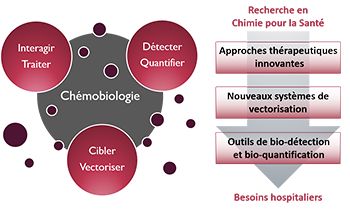- ⌂
-
Le DPM
Les Equipements
L'Environnement
Zoom sur... Le Bâtiment André Rassat
Nommé d'après une figure tutélaire de la chimie grenobloise, ce bâtiment est recouvert d’une double peau en feuille métallique qui apporte une protection thermique sur 3 côtés et crée une unité architecturale favorisant l'intégration parmi les arbres du site.
-
Thématiques
Le Thème
« Approches thérapeutiques innovantes »De nouvelles solutions thérapeutiques, de la cible biomacromolécu-laire émergente aux approches originales pour traiter les maladies
Le Thème
« Nouveaux systèmes de vectorisation »Combiner les propriétés d’inclusion de principes actifs, de franchisse-ment de barrières, d’adressage et de relar-gage en milieu vivant
Le Thème
« Outils de bio-détection et bio-quantification »Des dispositifs analytiques originaux pour la détection de cibles, de l’ion au micro-organisme en milieu complexe
Zoom sur... La Chémobiologie

-
Équipes
L'Équipe « COMET »
« COMET » développe la conception rationnelle, la synthèse et/ou l'extraction de composés à forte diversité/complexité comme nouveaux agents thérapeutiques et outils moléculaires pour la pénétration cellulaire ou la détection de biomolécules, actifs in vivo.L'Équipe « NOVA »
« NOVA » utilise des acides nucléiques fonctionnels comme éléments de reconnaissance pour des applications thérapeutiques ou diagnostiques, comme la sélection d'oligonucléotides, ou le développement de dispositifs d'analyses et de nanovecteurs.Les Services
-
Productions
Les Publications
La Vulgarisation
Les JSM
Zoom sur... La 12ème JSM (15 juin 2023)
Le DPM organise des journées scientifiques consacrées au médicament. L'objectif est de rassembler les spécialistes académiques et industriels autour d'une thématique. 2023 : Apports de la Chimie Click et de la Lumière en Chemobiologie
-
Partenariats
Les Formations
Les Consortiums
Les Financements
Zoom sur... L'environnement Grenoblois
Le DPM est un acteur central sur le bassin grenoblois en chimie, biologie et santé, lié au CHU Grenoble Alpes et à de nombreuses autres organisations : Pole de Recherche CBS, ICMG, Labex ARCANE, EUR CBH, Institut Carnot Polynat, Réseau GREEN.
Article
- Projet
- Farid OUKACINE,
- Titre
- Characterization of Carboxylated Nanolatexes by Capillary Electrophoresis
-
[Full paper
 ]
] - Auteurs
- F. Oukacine, A. Morel, H. Cottet
- Edition
- Langmuir 2011, 27, 4040-4047.
- Année
- 2011
- Résumé
- Poly(styrene-co-acrylic acid) (St/AA) and poly(styrene-co-methacrylic acid) (St/MA) nanolatexes with different acid contents were prepared by emulsion copolymerization and were analyzed by capillary electrophoresis (CE) and by laser doppler velocimetry (LDV). Due to the intrinsic differences in the methodologies, CE (separative technique) and LDV (zetametry, nonseparative technique) lead to very different electrophoretic mobility distributions. Beyond these differences, the variation of the electrophoretic mobility is a complex and nonlinear function of the hydrodynamic radius, the ionic strength, and the zeta potential. To gain better insight on the influence of the ionic strength and the acid content on the electrophoretic behavior of the nanolatexes, the electrophoretic mobility data were changed into surface charge densities using the O'Brien, White, and Ohshima modeling. This approach leads to the conclusion that the surface charge density is mainly controlled at high ionic strength (similar to 50 mM) by the adsorption of anionic surfactants coming from the sample. On the contrary, at low ionic strength, and/or in the presence of neutral surfactant in the electrolyte, the acid content was the main parameter controlling the surface charge density of the nanolatexes.




 Annuaire
Annuaire Contact
Contact Plan d'accès
Plan d'accès ENG
ENG Login
Login


